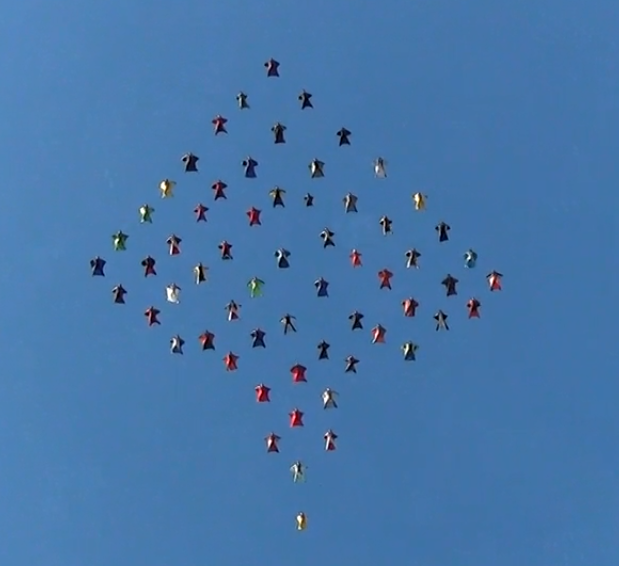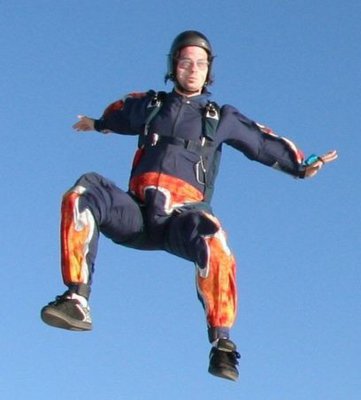Recommended Posts
SethInMI 174
Check out my cool mspaints that illustrate my point.
Some people dream about flying, I live my dream
SKYMONKEY PUBLISHING
kallend 2,219
The only sure way to survive a canopy collision is not to have one.
jsaxton 0
Piece 0
Try these settings:
Plane velocity: 65
Upper winds: 80
Lower winds: 0
Wind change: 10000
Delay: 5
We get 341 feet of separation. Change the uppers to 100: 287 feet of separation, a definite downward trend. Change the altitude of wind change to 11500: 58 feet.
Probably not relevant to skydiving unless people are jumping from the jet stream.
Proudly uncool since 1982.
Quotewhere triggered your question? setting aside all the stuff about high ground winds which wasnt indicated in your post, the logic behind exit orders is pretty well set, what the uppers are doing doesnt really change anything as they apply equally to all exiters. The RW/FF exit order is about freefall drift , which will be greater if the uppers are high so all the more reason to stay consistent.
I guess we did drift off topic for a minute
My momma said I could be anything I wanted when I grew up, so I became an a$$hole.
kallend 2,219
QuoteSuppose the plane is backing up relative to the winds at deployment. Playing with Kallend's program we see that, as the speed of the plane relative to the lower winds increases, the point at which the faster faller crosses the flight path of the slower faller gets lower. With the right kind of winds they can still end up on top of each other.
Try these settings:
Plane velocity: 65
Upper winds: 80
Lower winds: 0
Wind change: 10000
Delay: 5
We get 341 feet of separation. Change the uppers to 100: 287 feet of separation, a definite downward trend. Change the altitude of wind change to 11500: 58 feet.
Probably not relevant to skydiving unless people are jumping from the jet stream.
OK, as the program's author I should say that what you're seeing is a picture as seen by an observer on the GROUND, and for "normal" parameters this indicates pretty well what's going on and we can all relate to it. What you are seeing with the (headwind speed) > (airplane speed) is an apparent crossover when viewed by an observer on the ground. However, if the observer were in a hot air balloon moving with the airmass there would be no crossover. Since all freefall and deployment take place in the airmass, that is what is important. Relativity, and all that.
No, I'm not going to write a version with the observer in a balloon.
The only sure way to survive a canopy collision is not to have one.
SethInMI 174
You never come out answer the question directly. Do you think that given your comments on the nature of problem that the answer to the jsaxon's question is too trivial?
To BillVon et al: I played around with John's simulator and it verifed what I said, if the headwind is greater than the plane's airspeed, putting freeflyers out 1st gives greater seperation at deployment.
However, one thing I did notice from the program is that with the freefliers out 1st, they have alot of time under canopy before the belly fliers open. If winds are also high at opening altitude, they can be blown under the belly fliers while under canopy.
So in this hypothetical situation: from a purely freefall drift POV, freefliers out 1st gives greatest seperation between opening points. But depending on the lower level winds, canopy drift may change that.
Piece 0
In other words, I agree with you that if the wind never changed none of this would matter. That is why I had the wind change fairly high to a very different velocity. What am I not understanding?
Edit: I guess from the point of view of a balloon at exit altitude in the example I ran in your program, the groups will start moving away from the balloon, at the same rate (neglecting the time it takes to decelerate to zero velocity relative to the lower winds), once they cross into the lower winds. The freeflyers will spend less time moving away from the ballon than the bellyflyers and so the bellyflyers will end up closing on them from this coordinate system also. Is there a mistake I'm not seeing?
Proudly uncool since 1982.
Piece 0
QuoteHowever, one thing I did notice from the program is that with the freefliers out 1st, they have alot of time under canopy before the belly fliers open. If winds are also high at opening altitude, they can be blown under the belly fliers while under canopy.
Flying the canopy away from the group behind you will still cause you to move away relative to that group. The canopy still has the same airspeed, just not the same groundspeed. Flying the canopy towards the group behind you should be avoided in all winds.
I suppose it is possible to come up with examples where even flying your canopy away from the other group is not enough (very high winds at exit, then very low winds until almost deployment, then very high winds again)...
Proudly uncool since 1982.
kallend 2,219
QuoteJohn,
You never come out answer the question directly. Do you think that given your comments on the nature of problem that the answer to the jsaxon's question is too trivial?
Sorry if my replies were cryptic - but there's no need for a long explanation, I agree with billvon.
Moving the Earth around underneath doesn't affect the relative movements of the plane and skydivers with respect to the air they are moving through. (But it will affect where and how they land).
The only sure way to survive a canopy collision is not to have one.
jsaxton 0
The fact that the winds change the same for all groups. All groups are affected equally.
billvon 3,173
We don't really care about the distance between opening point 1 and opening point 2. I can choose a reference frame to make that distance be whatever I want. We want to determine the distance between the center of group 1 and the center of group 2 at the time that group 2 is opening - because too small a distance then will result in a possible collision. (This will be a point in the case of solos, or an area in the case of a group.)
SethInMI 174
SethInMI 174
I thought you were agreeing with Bill, but I just wanted to make sure. I know moving the Earth around does not affect what is happening in the air, but the is the reference frame we are using. The plane speed is 80 knots w/respect to the air. The airspeed is 100 knots w/ respect to the ground. So in defining the problem, you have brought the ground in as a reference.
Bill et al:
Look here are some simple numbers to illustrate my point, drawn from John's program:
Uppers 100
Lowers 0
Wind shear at 6000ft
Jump run at 70
10 sec btwn groups
Group seperation when 2nd group opens:
Freefliers out 1st : 2300ft
Belly fliers out 1st: 1800ft
Now if the lowers are not zero, then it changes quite a bit, but because the canopy drift, not freefall drift. I just think this whole talk of reference frames and "slow out 1st always is best" is not very helpful to understanding the correct answer to this admittedly very hypothetical question.
Seth
Piece 0
QuoteThe fact that the winds change the same for all groups. All groups are affected equally.
The point of putting slow fallers out first in most circumstances is that they spend more time in the wind and so are affected by it more. All groups are affected equally but for different amounts of time. Thus, the winds change at different points of their freefall trajectory and this can make a big difference.
I still think putting freeflyers out first in this situation is the right thing to do. All that matters is the motion relative to the air at deployment altitude and that air thinks that jumprun is backwards. The balloon will see the jumprun as happening downwind. Either way freefall drift is now working against you. The coordinate system is a red herring, final separation will not depend on it even if the frame is moving(obviously ignoring irrelevant stuff like special relativity). Perhaps I'm wrong. Either way it has to be full moon on a Friday before this makes any actual difference.
Proudly uncool since 1982.
billvon 3,173
>opening groups . . .
Easy.
Picture two otters on a zero wind day. Otter 1 is flying at a ground speed of 80kts at 13.5K. Otter 2 is at 3000 feet. They're both flying along in the same direction, almost one on top of the other. Otter 2 is back and to the left a little. Solo jumpers start getting out of otter 1.
An observer in Otter 2 sees the first jumper open 100 yards outside the door of his airplane. Then he sees the next jumper come along and open in EXACTLY THE SAME SPOT relative to him! Oh my God! Here comes jumper #3! They're gonna die! They're gonna . . . .
Then he notices that the canopies seem to be "blown backwards" somehow before the next jumper gets there. He sticks his hand out the door and notices an 80kt wind pushing his hand backwards. Aha! He figures. There's an 80kt wind up here that is pushing all the canopies backwards. So while it seems like he's standing still with respect to the other airplane, the jumpers are still getting good separation.
Now do the same experiment but with both airplanes flying in an 80kt wind. Now the observer on Otter 2 _and_ a ground based observer sees the same thing. Everyone opens in exactly the same place, but there are no close calls.
Now do the same thing but with both airplanes flying in a 100kt wind. The guy on the ground sees canopies opening close to each other in the wrong order (i.e. the first guy out is the farthest _ahead_) but again there are no close calls. The observer on the airplane notices nothing different.
Mark4 0
Here is another example:
Wind speed at altitude 120mph, we will assume exactly halfway through the free fall winds drop to 0.
Run in speed 60 mph
FF skydiver leaves 30 sec after FS skydiver. We'll assume the FF takes 30 sec and the FS 1 min
Distance travelled by FS skydiver 120mph*30sec/3600sec = 1 mile downwind
Distance travelled by FF skydiver in plane (120mph-60mph)*30sec/360sec = 0.5 mile downwind
Distance travelled by FF skydiver in free fall = 120mph*15sec/360sec = 0.5 mile downwind
Total 1 mile downwind. BAHM!
Is FS skydiver leaves 30 sec after FF skydiver then:
Distance travelled by FS skydiver is 1.5 miles downwind (0.5 miles in plane, 1 mile in freefall)
Distance travelled by FF skydiver is 0.5 miles downwind (0.5 miles in freefall)
I know this ignores throw forward etc but that does not significantly change the maths.
While this is hypothetical it is useful with respect to downwind run-ins… having said that, usually in the case of a true downwind run-in, the ground speed is so high the separation will be huge anyway.
Mark.






.thumb.jpg.4bb795e2eaf21b8b300039a5e1ec7f92.jpg)
the older I get...the better I was
Share this post
Link to post
Share on other sites